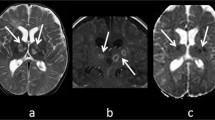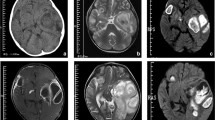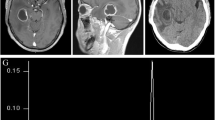Summary
The bacteriology for 21 patients with brain abscesses is presented and correlated with their predisposing conditions. Chronic otomastoiditis was the most common predisposing factor, and the overall most frequent infected sites were the frontal and temporal regions. Gram-negative non-sporeforming anaerobes of the genusBacteroides andFusobacterium followed by aerobic streptococci were the predominant pathogens. Enterobacteria were only identified in postcraniotomy abscesses, while a substantial number of fastidious species was detected in suppurations related to congenital heart disease. Altogether, anaerobes alone were recovered in seven patients, aerobes alone in six, and mixed aerobes and anaerobes in four patients. These findings confirm the predominant role of anaerobes in the etiology of intracranial suppurations.
Zusammenfassung
Bakteriologie und prädisponierende Faktoren von 21 Patienten mit Hirnabszeß werden vorgestellt. Der häufigste prädisponierende Faktor war die chronische Otomastoiditis. Am häufigsten waren die Frontal- und Temporal-Regionen infiziert. Gram-negative, nicht sporenbildende Anaerobier der FamilienBacteroides undFusobacterium und aerobeStreptococcus spp. waren die häufigsten Erreger, Enterobakterien wurden nur in Abszessen, die nach einer posterioren Kraniotomie auftraten, identifiziert. Bei Patienten mit angeborenem Herzfehler fanden sich vor allem langsam wachsende Spezies. Insgesamt wurden von sieben Patienten nur Anaerobier, von sechs Patienten nur Aerobier und von vier Patienten sowohl Aerobier wie Anaerobier isoliert. Die Bedeutung der Anaerobier in der Ätiologie der intrakraniellen Abszesse wird durch diese Befunde bestätigt.
Similar content being viewed by others
References
de Louvois, J., Gortvai, P., Hurley, R. Bacteriology of abscesses of the central nervous system: a multicentre prospective study. BMJ ii (1977) 981–984.
Brook, I. Aerobic and anaerobic bacteriology of intracranial abscesses. Pediatr. Neurol. 8 (1992) 210–214.
Rosenfeld, E. A., Roweley, A. H. Infectious intracranial complications of sinusitis, other than meningitis, in children: 12-year review. Clin. Infect. Dis. 18 (1994) 750–754.
Ariza, J. Casanova, A., Viladrich, P. F., Linares, J., Pallarés, R., Rufi, G., Verdaguer, R., Gudiol, F. Etiological agent and primary source of infection in 42 cases of focal intracranial suppuration. J. Clin. Microbiol. 24 (1986) 899–902.
Hlavin, M. L., Kaminski, H. J., Fenstermaker, R. A., White, R. J. Intracranial suppuration: a modern decade of postoperative subdural empyema and epidural abscess. Neurosurgery 34 (1994) 974–980.
O'Donoghue, M. A., Green, H. T., Shaw, M. D. Cerebral abscess in Merseyside 1980–1988. J. Infect. 25 (1992) 163–172.
Yen, P. T., Chan, S. T., Huang, T. S. Brain abscess: with special reference to otolaryngologic sources of infection. Otolaryngol. Head Neck Surg. 113 (1995) 15–22.
Facklam, R. R., Washington II, J. A. Streptococcus and related catalase-negative gram-positive cocci. In:Balows, A., Hausler Jr., W. J., Herrmann, K. L., Isenberg, H. D., Shadomy, H. J. (eds.): Manual of clinical microbiology, 5th ed. American Society for Microbiology, Washington D.C. 1991, pp. 238–257.
Kangsanarak, J., Fooanant, S., Ruckphaopunt, K., Navacharoen, N., Teotrakul, S. Extracranial and intracranial complications of suppurative otitis media. Report of 102 cases. J. Laryngol. Otol. 107 (1993) 999–1004.
Pit, S., Jamal, F., Cheah, F. K. Microbiology of cerebral abscess: a four-year study in Malaysia. J. Trop. Med. Hyg. 96 (1993) 191–196.
Lakshmi, V., Rao, R. R., Dinakar, I. Microbiology of brain abscess. Observations on 50 cases. J. Med. Microbiol. 38 (1993) 187–190.
Ersahin, Y., Mutluer, S., Guzelbag, E. Brain abscess in infants and children. Childs Nerv. Syst. 10 (1994) 185–189.
Vallée, L., Pinton, F., Martin, B. H., Debray, P., Vamecq, J., Hladky, J. P., Nuyts, J. P. Abcès cérébraux de l'enfant compliquant des caries dentaires. Arch. Pédiatr. 1 (1994) 166–169.
Meis, J. F., Polder, T. W., van de Kar, P., Hoogkamp-Korstanje, J. A. Multiple brain abscesses and bacteremia in a child due toFusobacterium necrophorum. Infection 21 (1993) 174–176.
Author information
Authors and Affiliations
Rights and permissions
About this article
Cite this article
Sofianou, D., Tsakris, A., Selviarides, P. et al. Etiological agents and predisposing factors of intracranial abscesses in a Greek university hospital. Infection 24, 144–146 (1996). https://doi.org/10.1007/BF01713323
Received:
Accepted:
Issue Date:
DOI: https://doi.org/10.1007/BF01713323




